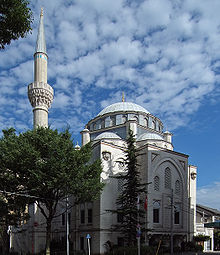Tokyo Mosque
| Tokyo Mosque | |
|---|---|
東京ジャーミイ | |
 | |
| Religion | |
| Affiliation | Sunni Islam |
| Leadership | Imam Ahmad Maeno Hafizahullah |
| Location | |
| Location | Shibuya, Tokyo, Japan |
 Shown within Special wards of Tokyo | |
| Geographic coordinates | 35°40′05″N 139°40′35″E / 35.66806°N 139.67639°ECoordinates: 35°40′05″N 139°40′35″E / 35.66806°N 139.67639°E |
| Architecture | |
| Architect(s) | Muharrem Hilmi Senalp |
| Type | Mosque |
| Date established | 30 June 2000 |
| Groundbreaking | 1998 |
| Completed | 2000 |
| Construction cost | 1.5 billion yen |
| Specifications | |
| Dome(s) | 1 |
| Minaret(s) | 1 |
| Minaret height | 41.48 meters |

Tokyo Mosque, Tōkyō-jāmii (東京ジャーミイ) also known as Tokyo Camii (pronounced Jamii), is a mosque with an adjoining Turkish culture center located in the Ōyama-chō district of Shibuya ward in Tokyo, Japan. It is the largest mosque in Japan.
Originally built in 1938, the current building was completed in 2000. It was designed by Hilmi Senalp, in a style inspired by Ottoman architecture.
History[]
The mosque was originally built along with an adjoining school on May 12, 1938 by Bashkir and Tatar immigrants from Russia who had come to Japan after the October Revolution. It was made under the direction of Abdurreshid Ibrahim, the first Imam of the mosque, and Abdülhay Kurban Ali.
In 1986, the mosque had to be demolished because of severe structural damage. Under the direction and support of Turkey’s Directorate of Religious Affairs, a new building was begun in 1998. The architect for the building was Hilmi Senalp. The ornamentation was based on Ottoman religious architecture. Around 70 Turkish craftsmen performed the finishing details, and a considerable quantity of marble was imported from Turkey. The construction was completed in 2000 at a cost of around 1.5 billion yen. The inauguration was held on June 30, 2000.[1]
Description[]
Tokyo Mosque is 734 square meters in area and has one basement floor and three above-ground floors with a total floor area of 1,477 square meters. Its main dome is 23.25 meters tall and is supported by six pillars, while the adjacent minaret is 41.48 meters tall.[2]
Notes[]
The word camii is a Turkish word derived from the Arabic word jami which means 'congregational mosque.'
See also[]
References[]
- ^ “New Tokyo Mosque opens”, in: The Japan Times, July 1st, 2000.
- ^ “Japan's largest mosque completed in Tokyo”, in: , Autumn 2000.
External links[]
| Wikimedia Commons has media related to Tokyo Camii. |
- Official Website - English, Japanese and Turkish.
- Information about the building[dead link]- Japanese
- Mosques in Japan
- Bashkir diaspora
- Mosques in Tokyo
- Russian diaspora in Asia
- Tatar diaspora
- Turkish diaspora in Asia
- Mosques completed in 1938
- Japan–Turkey relations
- Volga Tatar diaspora

